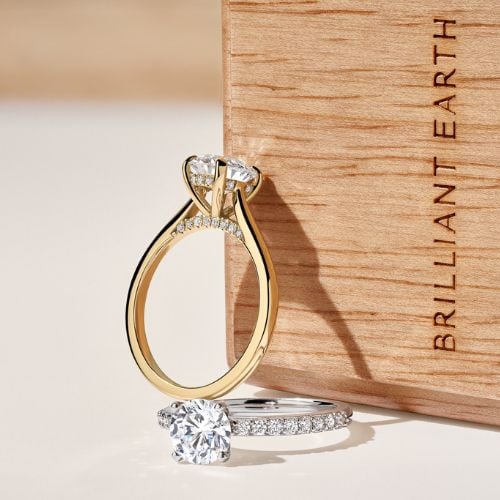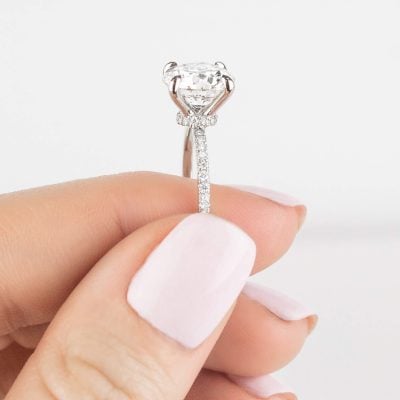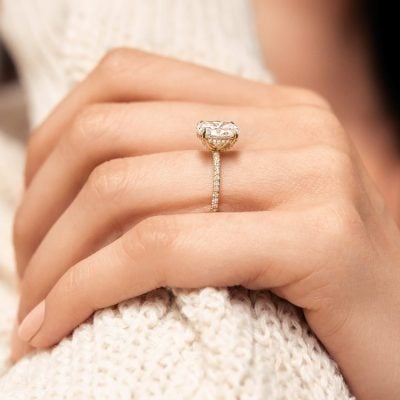
There are several ways to address the issue of a ring that’s too big, from simple at-home solutions to professional resizing. This guide will provide you with comprehensive information on how to handle a ring that is too loose, ensuring it stays safely on your finger.
How to Tell if a Ring is Too Big
A ring should fit snugly on your finger without causing discomfort. You can determine if your ring is too big by paying attention to a few signs:
- Slipping Off Easily: If your ring slides off your finger with minimal effort, it’s likely too large.
- Rotation: A ring that constantly spins around your finger, with the stone frequently ending up on the underside, is a common indicator that the fit isn’t secure.
- Visible Gap: If there’s a visible gap between your ring and your finger, it’s another clear sign that the ring is too large.

What to Do if Your Ring is Too Big
If your ring is too big, it’s important to address the issue to prevent losing it. There are several options available, depending on whether you want a temporary or permanent solution.
At-Home Fixes: For those seeking a quick, temporary fix, there are methods you can try at home, such as using a plastic ring adjuster. This is ideal if you need a temporary fix or are not ready to resize the ring permanently.
Professional Resizing: If the ring is significantly too large or if you want a permanent solution, professional resizing is the best option. A jeweler can resize your ring to ensure a perfect fit.
How to Make a Ring Smaller: At-Home Methods to Fix Your Ring
If you’re looking for a temporary solution to make your ring fit tighter, there are a few at-home methods you can try that won’t damage your ring. These methods are easy to implement and can be effective until you decide if you need a more permanent fix. Here’s our recommended at-home fix:
Plastic Ring Size Adjuster
Plastic ring size adjusters can be an affordable and effective way to make a ring fit tighter. You can purchase a plastic ring size adjuster, which typically comes in a coil, spring, or tube form. All you need to do is slip the adjuster onto the ring’s band to reduce the inner circumference, making the ring fit snugly on your finger. These plastic adjusters are typically available in clear or neutral colors, making it a subtle solution.
While the above method is safe, reversible, and comfortable, there are a few at-home methods that are not recommended. To avoid damaging the ring, please do not try:
- Tape: Wrapping tape around the band might seem like a quick fix, but it can damage the metal over time and leave a sticky residue that is difficult to remove.
- Glue: Applying glue to the inside of the ring band can create an uneven surface, leading to discomfort and potential damage to the ring’s metal and finish.
- Cutting the Band Yourself: Attempting to cut the band or make any permanent adjustments without professional tools and expertise can severely damage the ring.

How Professional Jewelers Resize a Ring
Professional jewelers offer a permanent and precise solution for a ring that’s too big. The resizing process involves reducing the size of the ring by removing a small section of the band and then soldering it back together:
- Assessment: A jeweler will first assess the ring’s material, design, and stone settings to determine the best approach for resizing.
- Cutting the Band: The jeweler cuts a small section out of the band to achieve the desired size.
- Soldering: After cutting, the jeweler carefully solders the band back together and polishes the ring to restore its original appearance.
- Final Adjustments: The jeweler checks the fit and makes any necessary final adjustments to ensure comfort and durability.
This method is reliable and maintains the ring’s structural integrity, though it may not be suitable for certain designs or materials such as eternity bands or rings with intricate detailing.
When NOT to Resize Your Ring
There are circumstances where resizing a ring is not advisable:
- Antique Rings: Resizing may weaken fragile settings or damage antique rings, making it a risky procedure.
- Eternity Bands: Rings with stones all around the band can be difficult or impossible to resize without compromising the design.
In such cases, considering alternative solutions like a ring guard or temporary at-home adjustments may be more appropriate.

FAQs
How much does it cost to get a ring professionally resized?
The cost of resizing a ring can vary widely depending on several factors:
- Materials: Rings made from softer metals like gold can be less expensive to resize than harder metals like platinum.
- Complexity of Design: Rings with intricate designs, multiple stones, or engravings may require more work, increasing the cost.
- Location: The cost can also vary depending on your location and the jeweler’s expertise.
On average, resizing a ring can cost anywhere from $50 to $200. However, more complex cases can cost significantly more.
Does resizing a ring make it weak?
Resizing a ring, when done professionally, should not weaken the ring if the correct techniques and tools are used:
- Soldering: The ring is carefully soldered back together, and the joint is reinforced to ensure durability.
- Metal Integrity: A skilled jeweler will take care to maintain the ring’s structural integrity during the resizing process.
It’s important to note that frequent resizing or poorly executed work can weaken the ring over time.
Whether you choose a temporary at-home fix or opt for professional resizing, understanding your options allows you to make the best decision for your situation. However, getting the right fit from the start is ideal. For more detailed guidance on finding your perfect ring size and preventing future sizing issues, be sure to check out our Ring Size Guide. This comprehensive guide will help you measure your finger accurately and choose a ring size that fits comfortably and securely.




